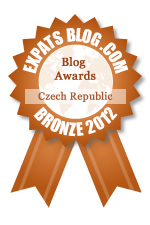By Ricky, on August 10th, 2012
A sand sculpture in Námestí Svobody, Brno © Ricky Yates
We spent the last weekend of our recent holiday, staying with our friends Lynsey and Johnny in Brno. It allowed me to get to know the second city of the Czech Republic better, having previously only paid flying visits there to plan, and then more recently to conduct, Church services. For Sybille, it was her first ever visit.
Walking into Námestí Svobody, the main city square in Brno, early on the evening of Friday 27th July, we found that a series of sand sculptures by various artists had been created as part of what is called the ‘Golden Sand Festival’. However, despite its English name, the associated website www.goldensandfestival.cz , is only available in Czech or Slovak! But I still have been able to glean from the website that this is the third year of . . . → Read More: Sand sculpture in Brno
By Ricky, on April 23rd, 2012
Our first outdoor beers of 2012 © Ricky Yates
Back in 1970 when I was just eighteen years old, I went off to see the world and emigrated from England to live in the Australian island state of Tasmania. As well as being a formative experience, one thing I discovered whilst living there, really surprised me. Despite Tasmania having at that time, a population of only just over 400,000, there was a great rivalry between those who lived in the south of the island, particularly in the state capital Hobart, and those who lived in the north of the island, either in the second city Launceston, or in the string of towns along the North-West coast.
Bearing in mind that Tasmania was and still is the smallest of the six Australian states, both in area and population, it did seem odd to me that there should be . . . → Read More: Rivalries within small states & nations
By Ricky, on November 4th, 2010
Arcaded building with sgraffito decoration in Telc © Ricky Yates
Leaving behind the Bata Canal and the valley of the Morava River, we drove westwards some 200 km to the little town of Telc, situated around 500 metres above sea level in the rolling hills of the far south-west of Moravia. Telc had been on my list of places to visit ever since I first read about it soon after arriving in the Czech Republic in September 2008.
The historic centre of Telc is surrounded on three sides by medieval fish ponds and access to it is via a narrow bridge and/or a gateway through the town wall. Inside the wall is the cobbled town square námestí Zachariáše z Hradce, which is surrounded by arcaded houses with beautifully decorated facades. These all date from the 16th century when the town was rebuilt by Italian masons in the . . . → Read More: Telc
By Ricky, on October 28th, 2010
Advert in the style of Alphonse Mucha for the Morava Restaurace a Disco in Uherský Ostroh © Ricky Yates
After the disappointment of the Wallachian Open-Air Museum being closed on Mondays, we left Rožnov pod Radhoštem and headed south, having lunch in and spending a couple of hours walking around the streets of the small spa town of Luhacovice, before arriving in the late afternoon, in the town of Uherské Hradište. Struggling continually trying to pronounce ‘Uherské Hradište’ correctly, we soon resorted to referring to it as ‘U.H.’!
As Professor Michal Novenko, our St. Clement’s Church organist had told me a few months previously, ‘Uherské Hradište’ means ‘the fortified place of the Hungarians’ – ‘Hrad’ being the Czech word for ‘castle’. The name is a reminder of past history when borders and peoples were not as they are now. I’m not sure how many Hungarians are left . . . → Read More: Uherské Hradište and the Bata Canal
By Ricky, on October 25th, 2010
Do you fancy a pasta salad with a horse called 'Fruity' galloping through it? © Ricky Yates
In a valley between wooded Moravian hills, lies the small town of Rožnov pod Radhoštem which is where we drove to after leaving Ceský Tešín. Rožnov had been recommended to us as a place to visit by several people as it is the home of the Wallachian Open-Air Museum where an amazing variety of historic wooden Moravian buildings have been preserved since the founding of the museum 85 years ago in 1925.
We arrived just before dusk and eventually found a place to stay within our price range in Penzion Becva, which didn’t appear in our guidebook, but which I fortunately spotted as we were about to leave the town to look elsewhere. Having been so well-fed at lunchtime, we then went out that evening looking . . . → Read More: More Czenglish and Museums don’t open on Mondays
|
rickyyates.com is a participant in the Amazon Services LLC Associates Program, an affiliate advertising program designed to provide a means for sites to earn advertising fees by advertising and linking to Amazon.
|



Recent Comments